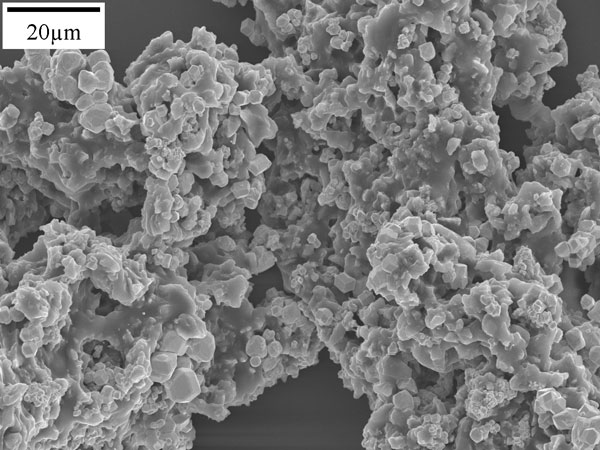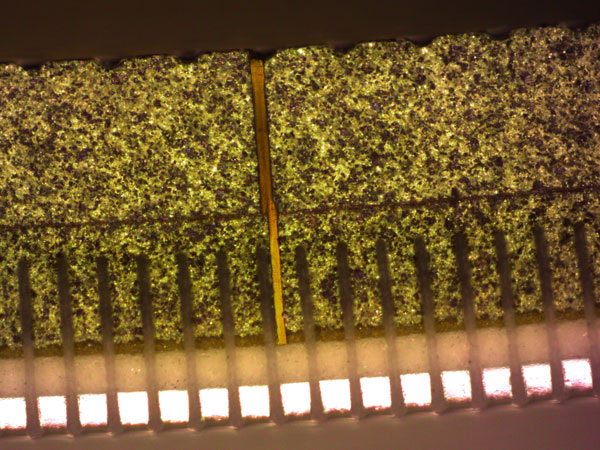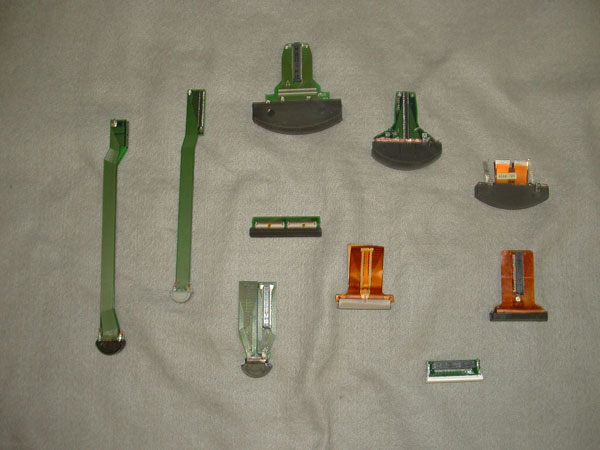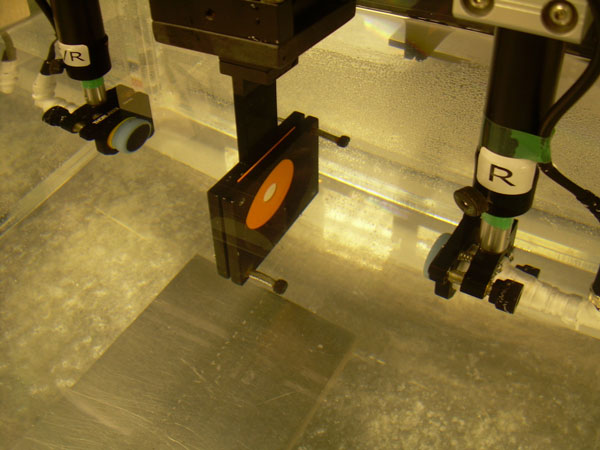Sylvan Acoustics, Inc - Ultrasound
For Sylvan Acoustics, Inc. founder Michael Zipparo, Ph.D., sound and audio engineering is the spark that led to a fascination with electroacoustic transducers. But ultrasound has been the primary area of professional technical development that he has been involved in since 1991.
Recently the field of ultrasound transducers for medical and other applications has experienced rapid advancements, including the ever-broadening commercialization of advanced piezoelectric materials such as PMN-PT single crystal and quarter wavelength mode backing layers. On a different technically challenging path, the area of therapeutic ultrasound has been challenging transducers in the area of power transmit efficiency, while dual use arrays demand sufficient performance for not only imaging but also therapy, from the same device and at the same time. And then distinct from the state of the art, conventional transducers are being challenged to be produced at ever-lower cost to serve the needs for less expensive and hence more accessible point of care ultrasound. Hence all together, the field of medical ultrasound transducers is quite the hotbed of innovation and development for performance and cost-effective clinical efficacy.
A sampling of various potential areas of collaboration or design service work are included below, including:
- piezoelectric materials
- passive acoustic materials
- design of array aperture and acoustic stack
- device prototype development and testing
- technical aspects of quality and regulatory guidance
- engineering and pre-production manufacturing
- and advanced manufacturing support
In addition to these individual areas, Sylvan Acoustics Inc. has extensive experience and a proven track record on R&D Grants. This includes writing proposals and winning awards for government support from NIH and DOD agencies, particularly for the SBIR/STTR program. We have also successfully served as subcontractors for longer term pre-clinical programs, e.g. R01 / R21 programs. We are actively pursuing opportunities to collaborate on these types of projects with investigators interested in leading edge R&D driven by technology or clinically innovative ideas.
Read on to learn more about the experience and capability of Sylvan Acoustics Inc., and then imagine how Sylvan Acoustics can help you to help people all over the world.
Piezoelectric materials
Piezoelectric materials are arguably the most important component of the ultrasound probe and the heart of the entire ultrasound imaging signal chain. These materials are used at least twice for each beam formation, first to transmit the sound into the medium being imaged (e.g. the human body or a body of water), and second to receive the echoes from regions of differing acoustic impedance. Many scan lines are combined to form an image of a 2-D plane or 3-D volume, where physical discontinuities can be seen as brighter or darker regions. All of this happens fast enough (individual beams transmitting and receiving hundreds to thousands of times per second) that even moving organs like the heart can be visualized in real time.
To properly design and optimize the performance of an ultrasound transducer, it is necessary to know the properties of the piezo material precisely. Sylvan Acoustics Inc. can help to characterize the following:
- Characterization of bulk piezoelectric material physical properties, including piezoelectric, dielectric, and mechanical coefficients in the full matrix format that are required to serve as input for finite element analysis programs such as PZFlex and Comsol Multiphysics.
- Calculation of a more limited set of coefficients to characterize a single operating mode for an element of an array or for a larger single element transducers. This can be used as an input for one dimensional transmission line models such as the KLM and Mason models. Though not as accurate as FEA models, with care the results can be reasonably accurate and the models run in seconds instead of hours.
Sylvan Acoustics Inc. has experience characterizing a variety of piezoelectric materials, including polycrystalline ceramics and single crystals, in various operating modes and from low to high operating frequencies.
Passive Acoustic Materials
Optimizing and understanding sources of variation of array and probe performance can benefit from an accurate assessment of the passive acoustic materials employed for various functions, including:
- Acoustic matching layers – Typically one to three matching layers are used between the piezo and the load to match the high acoustic impedance of the piezoelectric material to the relatively low acoustic impedance of a typical load medium (water or tissue). Accurate knowledge and control of acoustic speed of sound (velocity) and impedance (= density x velocity) is necessary to optimize device sensitivity and bandwidth and shape the frequency spectrum. For complete characterization, both longitudinal and transverse (shear) mode velocity and attenuation coefficients must be measured.
- Acoustic backing layers – Behind the piezo is a thicker layer of sound absorbent material, referred to as a backing layer or backing material. Sometimes an intervening layer of very high impedance material (a de-matching layer) is used to modify the portion of sound traveling towards the rear. These materials must also be well characterized to properly design the acoustic stack to minimize unwanted reflections from inside the array while maximizing the phase and frequency response of the forward traveling wave that is useful for imaging.
- Focusing and coupling materials – In addition to the acoustic stack materials, there are usually one or more intervening materials that either focus the sound and / or facilitate the transmission into the medium. Examples include soft and hard lens materials, e.g. RTV, urethane, TPX, etc., and various other materials used as coverings, domes, or coupling fluids for mechanically scanned 4-D probes. Again, accurate characterization of acoustic properties is essential for optimal design and the minimization of artifacts from internal reverberation.
Design of Array Aperture and Acoustic Stack
The acoustic radiation from the face of an aperture into a load medium (and reception from the field as well) will depend on the physical size of the aperture and the operating frequency. If the aperture radiates uniformly (e.g. the amplitude and phase of the displacement is constant across the aperture surface), the axial and lateral response can be described relatively simply. An aperture of separate elements in one or more dimensions provides additional control array of the radiated field. Adjustment of the timing (phase) and amplitude (apodization or shading) can be employed to steer the beam, focus or diverge the energy, reduce the side lobes, etc.
Sylvan Acoustics Inc. can help to design complex apertures for advanced custom applications where existing off the shelf products do not meet performance requirements. Some areas of particular emphasis include:
- Design of array active aperture for optimal performance, with proper consideration of necessary design constraints such as: operating frequency; total azimuthal (scan direction) and elevation (out of plane direction) dimensions; element pitch and total number of elements; shape of radiating aperture; elevation focal depth.
- Interconnect and packaging design for large element counts and minimal overall packaging volume, including such challenging designs as minimally invasive surgical probes and catheter-based arrays for ICE and IVUS applications.
- Acoustic stack design of active layers (piezo) and passive layers (matching, backing, lens) for optimal response (pulse or pulse-echo bandwidth, sensitivity, pulse length, etc.) to meet imaging or acoustic sound field requirements, as well as minimizing acoustic and electrical cross talk between elements, controlled or maximized angular directivity, etc.
Device prototype development and testing
Once the material fundamentals of a probe design are established, the real work of building the prototypes begins. Sylvan Acoustics Inc. has years of developing advanced prototype devices for the most demanding applications, where existing performance, packaging, or material processing limitations must be surpassed to meet the goals of the project.
Sylvan Acoustics Inc. has established working relationships with a range of companies that specialize in the development and / or manufacturing of advanced transducers, arrays, and finished probes. Potential areas of collaboration include:
- Development of signal interconnect and fabrication approach to meet device acoustic performance and overall packaging requirements, with particular emphasis on very small devices for minimally invasive surgical and catheter-based diagnostic imaging and / or image-guided therapeutics.
- Development of complex tool sets and fabrication sequences to meet all of the (sometimes conflicting) requirements for functionality, including bonding, dicing, curving, lensing, potting, etc.
- Collaborative and iterative progression of advanced testing, failure troubleshooting, and process adjustment and refinement to meet the requisite requirements for device performance, unit to unit uniformity, and field reliability.
- Probe to imaging system integration and image optimization, including consideration and of transmit front end, cable, array, and receiver electronics matching, as well as RFI/EMI emissions and susceptibility, channel to channel crosstalk, electrical isolation.
Technical support for quality and regulatory documentation and submissions
Sylvan Acoustics Inc. can assist with the technical documentation that is necessary to support a number of regulatory submissions, including IEC60601-2-37, ISO13485, FDA / CE Mark approcal, etc. …
- Design History File (DHF)
- Risk analysis
- Acoustic power and intensity
- Thermal (face temperature) testing
Manufacturing support (DFM, 6σ, statistical process control, etc.)
The complexity of material types and requisite functionality makes the fabrication of devices with consistent performance difficult. Sylvan Acoustics Inc. has extensive experience working with R&D, Engineering, and Production teams from companies both large and small to improve transducer, array, and probe uniformity, increase yield, and drive down unnecessary cost and scrap.
- Comprehensive and systematic use of root cause analysis to isolate specific problem areas (materials or processes)
- Use of DMAIC (Define Measure Analyze Improve Control) to understand the nature of the problem, organize existing knowns and unknowns, guide the development of adjusted or alternative processes or materials, validate successful improvements, and monitor continued process stability
- Advanced use of Scanning Acoustic Microscopy (SAM) to isolate and localize failures, and to assess the uniformity of acoustic properties of acoustic components and assemblies
- Data mining / statistical analysis (e.g. JMP, Minitab) of large data sets from manufacturing quality control testing to understand process stability and control and assess the effectiveness of modifications and improvements to materials and processes (e.g. TA, ECN…)
R&D Grants
Sylvan Acoustics Inc. is interested in developing close collaborations with investigators active in programs sponsored by government agencies (e.g. NIH, DOD, NSF)...



